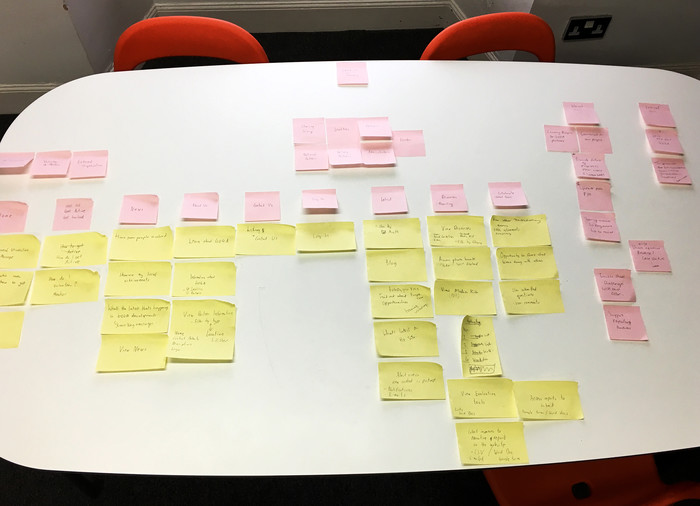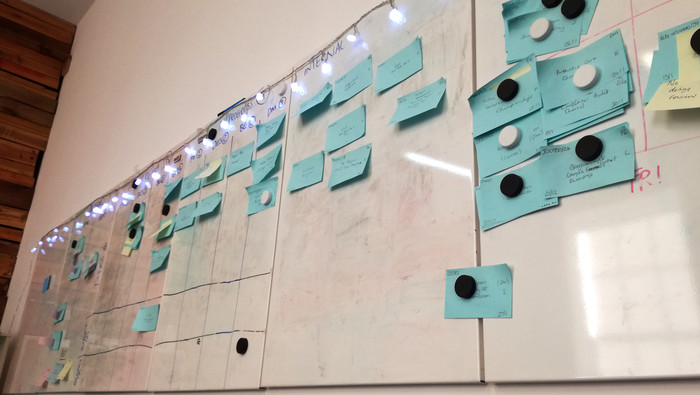The Agile Mindset
Agile. It’s not just a buzzword, it’s a mindset.
It can mean Scrum, stand ups and Kanban, but these are just names. Agile, to us, is the commitment to regular self evaluation and continuous self-improvement. The act of Agile brings empowerment and grows confidence, not only within your self, but within your team and with the client too.
An Agile methodology moves away from the idea that one department must finish their whole part of a project before moving to the next (also known as Waterfall). Adopting an Agile mindset takes an open mind - it can be hard to break free from the idea that everything must follow a chronological process. However, not doing so allows greater flexibility in timescales.
The process starts with an in-depth user workshop - evaluating not just what your company’s internal stakeholders think they need for launch, but what the primary users need to complete the key goals defined. From here, we establish a minimum viable product, as well as other “nice-to-haves” for development further down the line.

This way, costs, expectations and timescales are clear. Working to this process sees things move quick - feedback is quick and expert eyes from all channels feed in from the get go.
The result? A better product. Higher quality. Delighted users. Client goals smashed. Trust between agency and client is strengthened.
How We Work with Agile
Previously, our methodology was dictated to by rigid rules and processes - speaking with the client at the completion of every step. In theory, working this way would cover all the possible elements required for a successful project, whilst providing a consistent and efficient service.
However, the reality couldn’t be further from the truth. Working with an Agile methodology means that all data available at the beginning of the project is gathered, but unlike Waterfall, that’s not the end of the story. User workshops often unearth “hidden” needs, wants and “stories” that would have become apparent much later - or sometimes too late - in a Waterfall process.
This is when Agile comes into its own - the complete flexibility. When new users or priorities come to the surface, that’s ok. In the same vein, if a user group is identified as less dominant in the market throughout the process, we can adapt the project to reflect this too. Its piecemeal - rather than gathering all the information at the start and never reviewing the user priorities again in the process.
Unlike Waterfall, which aims for the big target from the get go, with agile, the answer is: start small, finish big. Focus on main priorities of your project, build the foundations and embellish the decor last. Think about the end user and evaluate all the time. That’s Agile in its simplest form.
Moving to Agile is not a switch you can make overnight, it's a mindset change. So, to begin to make the transition here at tictoc, we tested the water by introducing small changes, tackling smaller chunks of site builds one by one, having regular discussions with our internal teams and sharing the different stages with the client.

Then the bigger changes came - a Kanban board, regular catch up sessions to discuss improvements we can make together collectively - not just in our individual teams. It’s amazing how powerful an open forum for discussion can be, when everyone has an equal say. As each day passed the entire team became better and better at working together, then as the mindset changed, the individual improvements started to happen. Teams of different disciplines wanted to learn from each other, support others more proactively and improve their existing skill sets.
How Agile Works for You
It's not just an internal shift. The way we deal with our clients is totally different: they are more involved right from the start, all the way through the project and beyond. User workshops help us to reach a quick consensus on goals and objectives of a site, and the natural by-product of an initial site structure is formed. The project then evolves naturally as well work together to build a better, more successful product.
The results are phenomenal. More clients than ever have built up a solid, trusting relationship with us. They work with us on a regular basis to deal with the constantly changing markets, technologies and priorities of their complex organisations. We can scale up with their activities better than ever before.
There’s still a long way to go, but that's the point. Agile isn't a definitive process, it's a way of working. It’s like any sort of professional development - if you think you are there and you think you've made it, then that’s when you’ve lost. It's a constant evolution, of yourself, your processes, your interaction with others and your organisations needs.
You don’t choose to be “Agile” - you choose to be better at everything you do.